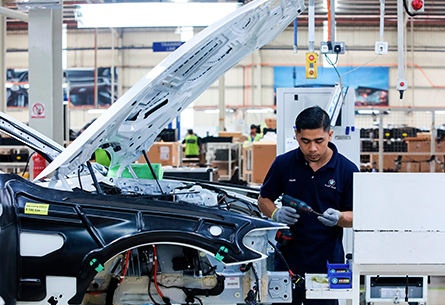Yes, the National Association of Industrialists (ANDI) is convening a ceremony at the port of Cartagena, where they will send a container of goods to the U.S. rate. This is the first export container under the FTA and is a symbol of things to come for the country: more exports to our largest trading partner, more investment, and therefore more industrial development and employment, which supports the the Government’s policy to internationalization the economy.
Colombian products with 0% tariff
- 99% of Colombian qualifying industrial and textile goods will become duty free upon the implementation of the FTA.
- 89% of Colombian agricultural goods will become duty free upon implementation of the FTA.
- Duties on many other tariff lines will be phased out over a period of up to 15 years, with some agricultural tariff rate quotas. While Colombia is expected to fill its new sugar TRQ, the FTA is likely to have a minor effect on U.S. imports and production of sugar and sugar containing products.

Key facts
The Colombia- U.S. FTA promotes trade in goods by eliminating tariff barriers, and by promoting the harmonization of technical regulations between both parties. As a result, FTA supports economic growth in both countries.
The FTA supports American jobs and improves American competitiveness since many American businesses use imports under this program as inputs to manufacture goods in the United States.
It is expected that the agreement will be effective in the second half of 2012, once Colombia accomplish all the agreement laws, regulations and policies. USTR is helping to accomplish these requirements as quickly as possible.
Colombia’s government is ensuring labor laws by promoting more protection rights for workers, to please and accomplish the strategic goals of the bilateral Labor Action Plan.
The USTR General Counsel, Tim Reif said that the FTA with Colombia is “well on the road” and is likely to be the next FTA to see implementation -GBD event on the pending FTAs.
United States Trade Representative Ron Kirk said “USTR has already started the work necessary to bring these agreements into force as soon as possible”- September 2011.
Colombia asked assistance in its labor to upgrade its workers rights from both the International Labor Organization and U.S. government. Mr. Kirk said:“It feels like they are absolutely meeting both the letter and spirit of what we asked them to do”.
Colombian products with 0% tariff
ATPDEA
The approval of the FTA extends the Andean Trade Promotion and Drug Eradication Act, ATPDEA, which was renewed until July 2013. The tariff preferences that many Colombian products have had shall be maintained with the FTA and therefore, sectors such as flowers, apparel, tobacco, cocoa, plastics and leather manufacturing, among others, shall be benefited.
In fact, both the ATPDEA preferences as well as the others that were agreed upon, shall be maintained over time, given that their persistence shall not be subject to unilateral U.S. Government and Congress decisions.
Agreements texts
The FTA is an agreement that generates opportunities for all Colombians, as it contributes to the creation of quality jobs and the improvement of the national economy’s performance. It benefits the exports sector, which will be able to sell its products and services under favorable conditions in the U.S. market.
The subjects that were negotiated were market access, in its two aspects (industrial and agricultural), intellectual property, investment regime, Government acquisitions, conflict resolution, competency, e-trade, services, environment and labor, among others.
The text of the agreement is embodied in one preamble and 23 chapters. The chapters cover aspects that reflect the general agreed-upon disciplines, many of which are common in multilateral and bilateral negotiations, and incorporate particular elements obtained by Colombia as well as by the United States in the negotiation.
For more details on the agreement, visit the Ministry of Trade, Industry and Tourism website at: http://www.tlc.gov.co/
FAQs about TLC
ANDI sources indicate that this will be loaded with textiles and apparel. Similarly, Asocolflores will be sending its first container of flowers on the same day, all with the zero tariffs that have come with the FTA.
The FTA covers almost all trade, services, and investment, so that the beneficiaries will be the sectors where businesses are proactive in seizing opportunities. Business tourism is one of them, given that initial trade and investment activities with the U.S. will increase the movement of businesspersons from both countries. Moreover, as of January 1, 2013, we will have open skies with the U.S. This is where airlines can fly cargo or passengers to any city in both countries. The opportunities that this FTA brings will help Colombia to become a world-class destination.
Yes, this FTA shall be a formula for growth, and it is similar to those agreements that other countries have signed with the U.S. It is also is a policy that complements the Development Plan, as it contributes to growth through the elimination of obstacles and uncertainties. And thanks to this FTA, Colombia can be a platform for companies wanting to establish in the region in order to receive the benefits of the FTA, so as to increase their sales to the U.S.
No, this is an erroneous message, as this Law doesn’t have anything that resembles what is known as the “Lleras Law,” which was not approved by Congress.
This is also untrue. Nothing has been altered in terms of internet use. The Law contains provisions that were already pre-approved by the Colombian Congress in 2007, and a big portion of it content form part of the decisions made by the Andean Community. What was approved did not yet formed part of our legal system.
This is because the Free Trade Agreement that was signed with the U.S. sets out commitments that are required to become laws of the Republic prior to the entry into force of the FTA. Thus, this new law conforms to standards established and approved by Congress beforehand. This included, for example, updating legislation contained in Law 23 of 82, Law 44 of 93, and even Andean decisions that enshrine the rights of access to information and free expression.
Absolutely! Colombian legislation has, for many years, established exceptions for students, teachers, researchers, and so forth. Using information in good faith and without the intention of making a profit shall proceed without any problems. Again, this Law does not change an internet user’s access because no new sanctions, limitations, or restrictions to the
flow of knowledge have been incorporated. On the other hand, if a user intends to make money on such information, then yes, there will be a problem.
If you are permitted to use a camera at the event, then yes, you can record it. What the law prohibits is to conduct a live broadcast of the concert, unless you have paid for the respective rights. By the way, to do so otherwise has been banned since the mid 90s.
Among other actions, businesses have analyzed which inputs and imports become cheaper as a result of reduced tariffs. They have also identified significant opportunities vis-à-vis competitors, such as Brazil, Argentina, and China, where they pay tariffs above 5%. So, this opens up the prospect of capturing some new markets in the U.S. The Administration, Congress, and the Constitutional Court have done their part in realizing this FTA, now it is up to businesses to make the most of it.







